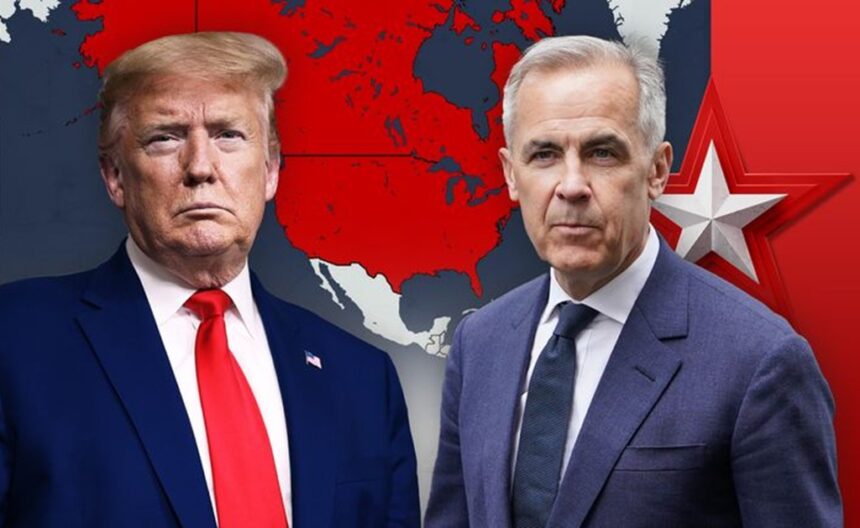OTTAWA – When Donald Trump returned to the White House in January 2025, he brought a strong focus on tough trade actions, especially toward Canada, America’s closest neighbour and biggest trading partner.
His decision to add new tariffs on Canadian products, along with talk about making Canada the “51st state,” has shifted the mood in Canadian politics. Underneath the tough talk, a new pattern has come to light: Trump seems to prefer dealing with a Canadian Liberal government under Mark Carney, rather than a Conservative one led by Pierre Poilievre.
This surprising choice, shared by Trump and discussed widely among politicians, raises questions about trade strategy and what each leader brings to the table. After reviewing public comments, policy decisions, and feedback from those close to both leaders, it’s clear Trump believes a Liberal government offers him an easier trade partner, and Carney’s moves may have helped set this up.
Trump’s View: Carney Easier to Sway
In March 2025, Trump made waves on Fox News with Laura Ingraham, saying, “I deal with every country, directly or not. One of the toughest is Canada… Trudeau—I call him Governor Trudeau—his team was harsh and dishonest. But with Carney, it’s different. Liberals are weaker negotiators than Conservatives. They give in faster.”
This wasn’t the first or only time he made this point. Canadian Conservatives like MP Larry Brock shared posts on X, claiming Trump prefers Carney because he thinks he’s “weak, compromised, and easy to push around.”
Trump links this to a long-held belief that Liberal governments, who tend to favour global cooperation, don’t push back as hard as their Conservative rivals. Pierre Poilievre, the Conservative leader, ran on a “Canada First” message, much like Trump’s “America First” pitch, promising to stand firm against U.S. trade demands.
Poilievre talked up defending Canada’s independence and using the country’s energy resources, like its key role in supplying oil to the U.S., to fight back against tariffs.
In contrast, Carney, who has held major roles at global banks, has pushed for a more cooperative approach, stressing “win-win” trade with Europe and Asia. For Trump, this signals Carney is more open to talks and less likely to dig in, making negotiations easier for the U.S.
Brookfield’s Move: Carney’s Calculated Step?
A key moment was Carney’s link to Brookfield Asset Management, a major Canadian firm where he was board chair before moving into politics. Just before Trump rolled out his tariff plan in late 2024, Brookfield shifted its head office from Toronto to New York City.
The timing raised eyebrows, and Conservatives jumped on it. Andrew Scheer, a senior Conservative, posted on X, “Six days after Trump announced tariffs, Carney moved his company headquarters to New York, right near Trump Tower.” Another user, @ShaziGoalie, hinted that Carney’s move looked like he was making things easier for Trump, saying Liberals were “prepping the field” for American control.
Carney has tried to distance himself, saying the board made the final call after he left in early 2025. But a leaked letter, shared by Conservatives, shows Carney suggested the move in December 2024, mentioning “strategic market opportunities” in the U.S.
This shift helped Brookfield dodge the bulk of Trump’s tariffs, which hit 62% of Canadian imports not meeting USMCA rules. Critics say Carney put business interests ahead of Canada’s, which fits with Trump’s push to pull jobs and investment to America.
As @sheilawalker73 wrote on X, “Carney told Canadian business it’s fine to move jobs south, just like he moved Brookfield to NYC.”
This episode has sparked talk that Carney’s practical style makes him easier to predict in talks with Trump. Compared to Poilievre, who vowed to boost oil and gas to push back against the U.S., Carney seems to prefer calming markets over sticking up for Canada at all costs. Trump, who has a knack for spotting weak spots, likely views Carney’s global focus as a chance to drive a harder bargain.
Politics Shift: Trump Gives Liberals a Boost
Trump’s tough stance helped Carney rise to power. By December 2024, Justin Trudeau’s Liberal government was falling apart, trailing Poilievre’s Conservatives by a wide margin. Trump’s tariffs and talk of annexation fired up Canadians, turning the April 2025 election into a showdown over national pride.
Carney, who once ran the Bank of Canada and the Bank of England, took over the Liberals in March 2025, pitching himself as a calm hand during tough times. His campaign was all about warning voters that Trump wanted to “break us so America can own us.” The message worked. The Liberals squeaked out a narrow win, just missing a majority.
The irony is that Trump’s attacks may have helped Carney grab power. But Carney’s win comes with limits. He leads a minority government that depends on the New Democrats or Bloc Québécois to pass laws, which means he can’t take a hard line without risking his position.
Experts like Laura Dawson from the Future Borders Coalition urge caution, pointing out that Canada’s trade deficit and smaller economy mean it has less room to push back. Trump knows this and told reporters that Carney would be in Washington “within the next week or less” to strike a deal.
Trade Talks: What’s on the Table?
Carney’s first meeting with Trump in Washington is set for May 6, 2025. There’s a lot at stake. Trump has held off on some tariffs until July, but the threat of 25% duties on Canadian exports looms, especially for industries like cars and energy.
Carney has promised to keep Canada’s counter-tariffs in place, hitting $42 billion in U.S. goods, but warns that taking things further could hurt Canadians more than Americans. He’s focused on expanding trade with partners like the EU and ASEAN, and using Canada’s energy exports, like fertiliser that U.S. farmers need, to win some ground.
At the same time, Trump’s team isn’t in a hurry. They’re working with Asian countries first and plan to circle back to North America later in the summer. This delay could help Carney, giving him time to unite Canadians and build a clear trade plan.
Erin O’Toole, a former Conservative leader, says Carney needs to focus on keeping the country together, especially in Alberta, where talk of breaking away has flared up again. Still, Trump sees Carney as a softer negotiator, which could push the U.S. to demand more access to Canadian resources or changes to USMCA.
Bigger Picture: Canada’s Place in the World
Carney’s win is making waves beyond North America. He’s seen as someone who could help bring together other countries to stand up to Trump’s protectionist push. His experience running two major central banks gives him credibility, and he plans to use the G7 summit in Alberta this June to build new trade ties.
But at home, his weak minority government and the fallout from the Brookfield move make his position shaky. Posts on X, like one from @JudahsLife, even claim Trump and Carney struck a backroom deal months ago, with Brookfield’s move as proof. While there’s no solid evidence, these ideas show many Canadians worry that Carney may bend too much to U.S. wishes.
Trump’s preference for Mark Carney’s Liberals boils down to seeing them as an easier negotiating partner. Trump sees Carney’s global outlook and practical mindset—shown by the Brookfield move—as chances to win better terms for the U.S. Carney, meanwhile, has to juggle the pressures at home and still show he can stand up to Trump.
As trade talks loom, Canadians are left wondering if Carney can surprise Trump and protect Canada’s interests, or if his government will give in under U.S. pressure. The outcome will decide not just Canada’s trade future, but also how countries handle growing protectionism worldwide.








